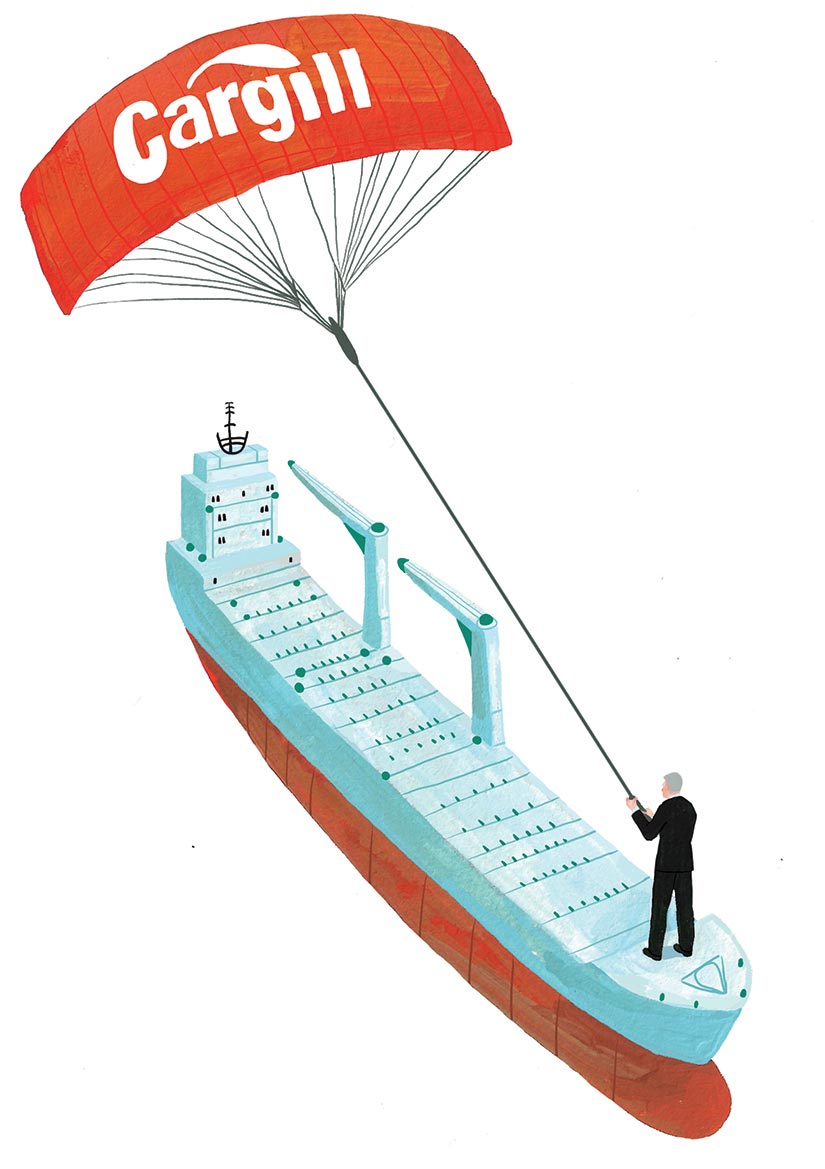6 Greenwashing Schemes That Show Corporations Will Never Lead on Climate
More and more companies are setting public goals for reducing their greenhouse gas emissions. History shows they can’t be trusted.
Christine MacDonald

This article is part of Covering Climate Now, a global collaboration of more than 250 news outlets to strengthen coverage of the climate story.
Forget the youth activists capturing the country’s imagination with calls for a Green New Deal and the progressive politicians pushing for it: The clearest signal that climate change demands action comes from the planet’s corporations.
Corporations worldwide are announcing new plans to eliminate climate impact from their operations, and would have you believe they are well on their way to building the green economy voluntarily, no need for major economic reform. It would seem the dirtier the industry, the bigger the ambition. HeidelbergCement, for example, the world’s second-largest cement producer, pledged to produce carbon-neutral concrete by 2050, a goal in line with the Paris Agreement. It was a first for an industry that is the world’s third-largest industrial energy consumer, according to the International Energy Agency. Xcel Energy, meanwhile, one of the biggest utilities in the United States, is closing coal-fired power plants and moving aggressively into wind and solar renewables, claiming it will be “carbon-free” by 2050.
Corporate sustainability programs today extend to suppliers and subcontractors, as well, and some big banks are beginning to factor climate change risk assessments into their lending decisions. Even ExxonMobil, arguably the most environmentally unfriendly corporation of all time, claims, “We believe that climate change risks warrant action and it’s going to take all of us — business, governments and consumers — to make meaningful progress.”
It’s little wonder that executives are worried: A 2019 survey of 215 large companies from the nonprofit CDP found they expect to lose as much as $1 trillion from climate impacts in years to come. Clean energy would save money in the long run while winning reputational currency with consumers. Yet few of these corporations have put their heft behind robust government climate policies. In fact, polluting corporations have poured millions of dollars into lobbying efforts against new environmental regulations, suggesting they only want climate action if they set the terms.
But could voluntary corporate environmental cleanups and self-policing solve the problem? To answer, In These Times looked back at some of the most ambitious corporate environmental promises of recent decades. It’s not very encouraging.
1
The transportation sector is the biggest pollutor in the U.S., accounting for 29% of total emissions in 2017, according to the Environmental Protection Agency. Medium-duty and heavy-duty trucks (for cargo, firefighting and other services) contribute 23% of transportation emissions; these emissions increased by 90% between 1990 and 2017. Commercial ground shipping is poised to remain a major polluter for the foreseeable future.
The picture once seemed rosier. In 2000, FedEx teamed with the Environmental Defense Fund to develop a “revolutionary” hybrid truck design to bring down greenhouse gas emissions by 30% while reducing air pollution. FedEx planned to start replacing its dirtier-burning diesel trucks in 2003 with the potential of rolling out 30,000 new vehicles in a decade. “I can’t envision any reason why we wouldn’t roll this out over the whole fleet,” one executive said.
“By making this commitment, they are taking a giant step forward for the environment in the United States,” Geroge W. Bush’s EPA administrator, Christine Todd Whitman, told the New York Times.
The revolution never took hold. By 2010, FedEx had added only a few hundred electric and hybrid vehicles, citing the “daunting” costs of purchasing or converting vehicles.
Today, the company has fewer than 4,000 “alternative energy vehicles” on the road — about 2% of its ground fleet of 180,000+ vehicles worldwide, lagging behind UPS (with more than 10,000 alternative fuel vehicles in its total fleet of 123,000).
After balking at the cost of a new green fleet, FedEx (like much of the ground shipping industry) has refocused its “sustainability” work on relatively low-hanging fruit such as making improvements to its existing fleet’s fuel efficiency (which can save money without major new investments). FedEx has made strides, improving fuel efficiency 39.6% from a 2005 baseline, and claims to still be “revolutioniz[ing]” the industry. But none of this moves to transition corporate ground fleets to renewable fuel.
2
Maritime shipping, one of the more difficult sectors to decarbonize due to the lack of viable alternative fuels at the ready, accounts for 2.2% of the world’s carbon dioxide emissions, according to the United Nations International Maritime Organization.
In 2011, the international commodities trader Cargill captured imaginations by installing a giant kite on the dry bulk cargo ship Aghia Marina, making it the world’s largest kiteassisted cargo ship. The system works by harnessing powerful high-altitude winds to propel cargo ships, reducing fuel consumption by up to 35% (depending on weather conditions) according to SkySails, the German engineering company that pioneered the concept.
Fuel is one of this industry’s biggest costs, so adding sail technology seemed like a win-win. The pilot ship grabbed international headlines and appeared poised to scale up to become a new industry standard.
Even the online environmental site TreeHugger praised Cargill, saying, in 2011, that the project was “worth recognizing” (even as they remained critical of some of Cargill’s other practices).
 But by 2015, Cargill was saying that it had “encountered obstacles that demonstrate the challenge of making windpowered vessels a reality,” and the project was ended. The Aghia Marina was sold in 2017, around which time the SkySails system was removed, according to SkySails founder Stephan Wrage.
But by 2015, Cargill was saying that it had “encountered obstacles that demonstrate the challenge of making windpowered vessels a reality,” and the project was ended. The Aghia Marina was sold in 2017, around which time the SkySails system was removed, according to SkySails founder Stephan Wrage.
“I think [the sail system] should have been installed on a new vessel,” Wrage says. But that never happened. Cargo ship owners, Wrage says, have generally resisted adopting new technology such as kite sails, despite the proven cost savings. The reason is that cargo ship owners aren’t the ones paying for fuel. Fuel costs are passed onto charter customers (like Cargill), so the ship owners generally don’t make expensive energy efficiency upgrades, no matter the climate-saving potential.
Cargill, apparently, was unwilling or unable to leverage its international stature and business scale to push for a sea change in the shipping industry. Nevertheless, today it still wants full credit for its short-lived sail experiment, insisting that its aborted pilot project “does underscore Cargill’s commitment to investing in innovative shipping solutions that aim to transform the industry.”
3
Aviation makes up roughly 3% of global greenhouse gas emissions, one of the fastest-growing sources. Since the mid-2000s, some airlines have offered passengers a chance to assuage their own carbon guilt by purchasing carbon offsets: For an extra fee, flyers buy into forest management and other environmentally friendly projects to balance out the carbon they’re using. Virgin Atlantic Airways helped lead the charge — on the public relations front, at least.
Promising its carbon offsets are tested against “strict criteria about what counts as a carbon reduction,” Virgin assures customers that carbon credits support environmental conservation and improve “people’s lives by delivering household savings, health benefits and improving water resources.”
But at least one offset project advertised by Virgin has proved to be a sham. The environmental and social justice organization Fern issued a failing grade, in 2017, to Virgin’s offset credits for forest conservation in Oddar Meanchey, Cambodia. An investigation found that nearly half of the forest that was supposed to be protected had been clear-cut. Fern’s Julia Christian told the Phnom Penh Post those carbon credits “are bogus — they are based on emissions savings that never happened, because the forest was destroyed, not protected.”
A few months after Fern’s report made international headlines, Virgin stopped selling the Oddar Meanchey offsets.
A Virgin spokesperson said the company had acted “in good faith” when selecting the project, though critics had publicly raised concerns years prior.
 It’s not that preserving forests isn’t an effective decarbonization method, but that forest offset programs too often fail to prevent deforestation. In May 2019, ProPublica issued an investigative report that examined two decades of offsets and concluded that forest carbon credits “may be worse than nothing,” giving “polluters a guilt-free pass to keep emitting CO2” with little to no climate benefit. The programs are also controversial with social justice and indigenous rights groups who see local communities losing their age-old ways of life after conservationists cut off their access to hunting, fishing and foraging.
It’s not that preserving forests isn’t an effective decarbonization method, but that forest offset programs too often fail to prevent deforestation. In May 2019, ProPublica issued an investigative report that examined two decades of offsets and concluded that forest carbon credits “may be worse than nothing,” giving “polluters a guilt-free pass to keep emitting CO2” with little to no climate benefit. The programs are also controversial with social justice and indigenous rights groups who see local communities losing their age-old ways of life after conservationists cut off their access to hunting, fishing and foraging.
Despite these problems, the International Civil Aviation Organization’s Carbon Offsetting and Reduction Scheme for International Aviation (CORSIA) is still relying on offsets for its industry-wide goal of carbon-neutral growth by 2020.
4
Thomas Mooney, senior vice president for sustainable growth at Fiji Water, claimed in a 2008 press release, “Consumers who choose Fiji Water will actually be helping the environment by taking carbon out of the atmosphere with every purchase.” Labels reading “every drop is green” appeared on Fiji bottles in supermarkets and hotel rooms, along with a “carbon neutral” claim. But very few things in life are truly carbon-free.
Producing plastic bottles and shipping water from Fiji to the rest of the world comes with a heavy environmental cost, and Fiji’s promise to neutralize “120%” of its carbon emissions was based on so-called forward crediting, a scheme that allowed the company to tout its carbon-negative status in 2008 even though its emissions wouldn’t (theoretically) achieve that status until 2037, according to calculations by the international nature group, Conservation International (CI), that partnered with Fiji on the project. The idea was to rely on conservation projects in Fiji — which, we know, is no guarantee of forest preservation. Billionaire Stewart Resnick, who co-owns Fiji Water, happened to be a longtime CI board member, and CI worked for Fiji Water in exchange for conservation funding. (Full disclosure: This author briefly worked for Conservation International in 2006, which led to her whistleblowing book, Green, Inc.: An Environmental Insider Reveals How a Good Cause Has Gone Bad.)
In 2011, a California woman launched a class-action lawsuit arguing Fiji was “claim[ing] credit for carbon removal that may or may not take place — up to several decades in the future.” The case was dismissed, but the company has stopped using the carbon-neutral label.
5
Remember “Beyond Petroleum”? In 2001, the oil company BP (formerly known as British Petroleum) rebranded as an environmental champion, adopting its “Beyond” slogan.
Its solar subsidiary, BP Solar, was a big part of the Beyond Petroleum efforts. In its mid-2000s heyday, solar panel manufacturer BP Solar enjoyed a brief era of profitability. In 2004, the company reported, “The solar business grew sales by 38% and delivered a full-year operating profit for the first time.”
Shortly after that record year, however, Chinese solar panel manufacturers introduced cheap new products to the market. By 2008, Chinese solar panels were selling for 80% less than others in the industry, driving out competition and allowing China to seize a leadership position in solar that it still maintains.
By 2010, BP’s solar subsidiary was already feeling the heat of Chinese competition when the Deepwater Horizon oil spill left 11 workers dead and allowed 4 million barrels of oil to flow into the Gulf of Mexico, a serious crack in the company’s green image. BP Solar closed in 2011, succumbing to Chinese competition, and the Beyond Petroleum slogan soon faded away.
BP did not buy its way back into solar until December 2017, with a $200 million investment in Europe’s largest solar developer, Lightsource. But the company has never been close to going beyond petroleum — then or now.
Even in 2004, 96% of BP’s net profits came from dirty old fossil fuels, with just 4% coming from solar and other renewables. In 2018, meanwhile, the company reported $12.7 billion in underlying replacement cost profit (effectively net income), which highlights the tiny nature of its $200 million Lightsource solar investment. As Valentina Kretzschmar, the director of research at oil analysis firm Wood Mackenzie, put it in 2018, “the amount of money spent is still peanuts compared to their core business.”
6
U.S.-headquartered commodities traders Archer Daniels Midland (ADM), Bunge and Cargill, which supply world markets with a vast array of raw materials, have long stood accused of encouraging farmers to cut deeper into the Amazon and other forests, bulldozing biodiverse ecosystems to make way for fields of soybeans, African palm and other cash crops.
Various corporate sustainability programs have committed to stop purchasing commodity crops grown on recently deforested land and all three of the aforementioned big traders have turned to “traceability” systems to account for every grain, seed and fruit in a supply chain and link them back to where they grew. Bunge says it has achieved more than 90% traceability for farms it sources from directly in “high-priority areas” around the world and is monitoring more than 6,700 farms and 200 independent grain elevators. Cargill has pledged “to transform our agricultural supply chains to be deforestation-free.”
However, “The Ultimate Mystery Meat,” a 2017 investigation by the activist organization Mighty Earth, charged Bunge and Cargill with driving deforestation in Brazil and Bolivia.
“Bunge has adopted a strong policy on paper to prohibit deforestation in its supply chain, but hasn’t widely communicated the policy to its suppliers,” the report reads. And “Cargill has given itself until 2030 to eliminate deforestation from its supply chains, giving soy growers and others almost 15 years to race to clear as much forest as possible.”
The problem is industrywide. Geospatial analyst Philip Curtis, a researcher with the Sustainability Consortium, found that forest clearing for commodities crops remained steady between 2001 and 2015, with an area the size of Costa Rica lost every year to industrial agriculture. “The scale of the loss was staggering,” he told Science.
Corporations clearly have robust information about climate impacts, and the significant resources needed to address the problem. And despite rampant greenwashing (revealing a commitment to public relations rather than real sustainability), corporate leaders have undeniably elevated the public conversation about climate change while politicians have too often remained silent. Arguably, however, they do so only as far (and as often) as public opinion requires.
As we’ve seen from FedEx, Cargill and others, some of today’s most successful and ruthlessly competitive corporations — despite claiming to be transforming an industry — have exhibited a surprising lack of grit, quietly folding at the first obstacle to their boldest green ambitions.
This apparent inconsistency often seems deliberate, with companies demanding climate action while supporting trade associations and politicians who deny that climate change is even happening. Many continue protecting old business models, while hedging their bets with new clean tech products and services. Some of today’s biggest polluters — oil and gas companies and big utilities — are planning for big profits from the renewable energy transition, even while continuing business as usual for as long as possible.
History shows that individual corporations have failed to follow through on promised change without government regulatory action. “I don’t think [the transportation] industry would [decarbonize] if they are not highly incentivized to do it, or required in some aspects,” says Lewis Fulton, director of the Sustainable Transportation Energy Pathways program at the University of California, Davis.
The failure of corporate sustainability efforts also bodes poorly for the kind of laissez-faire policies that corporations hold up as the answer to climate change. These include market-based pricing mechanisms, such as cap and trade, which not only rely heavily on offsets but implicitly trust corporations to set their own path toward sustainability with limited state intervention. “Making tweaks to a market mechanism and hoping that industry will respond correctly” will likely be insufficient, says Brian Nowicki at the Center for Biological Diversity. What’s needed are “bold actions where we actually redirect where our resources are and what we are investing in as a state and as a country.”
The renowned late environmentalist David Brower is credited with saying that all environmental victories are temporary, while each defeat is a permanent loss. The opposite could be said of corporate sustainability claims: Corporations want everlasting credit for their investments in nature, but for their failures to be instantly forgotten.
Christine MacDonald is an investigative reporter and author, whose work focuses climate change, environmental sustainability and greenwashing. She was a 2019-2020 fellow with the Leonard C. Goodman Institute for Investigative Reporting.









